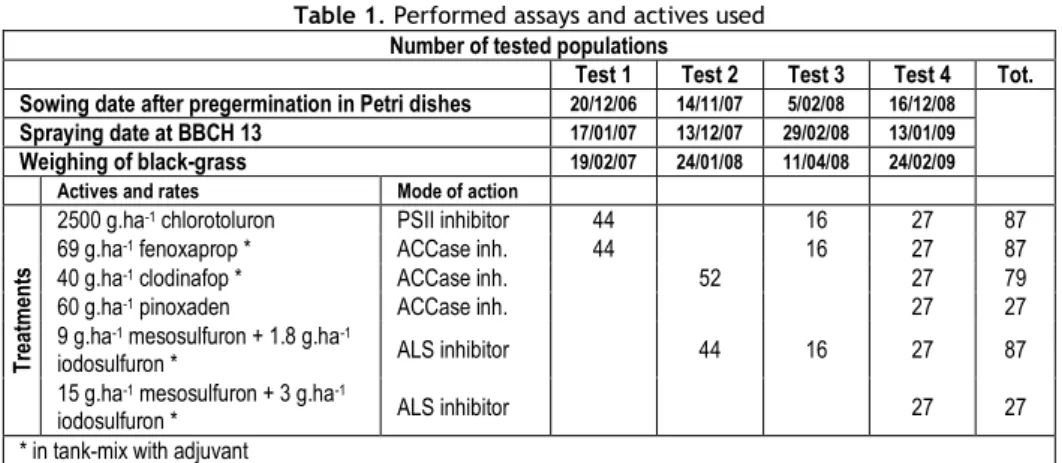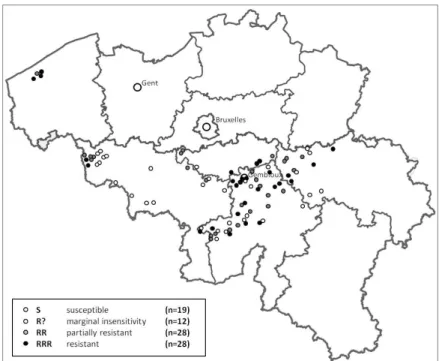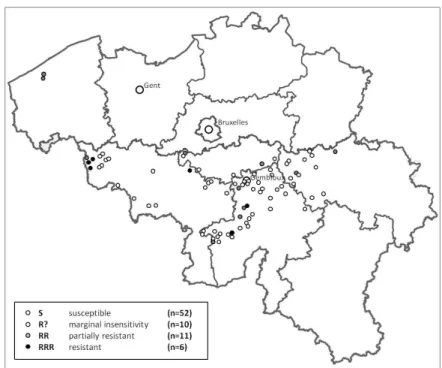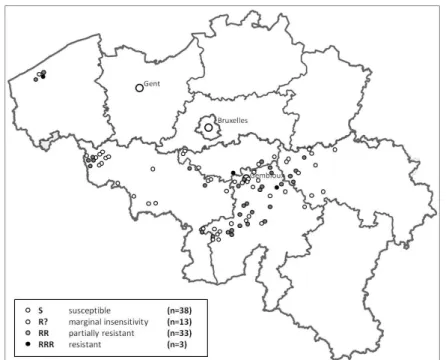BLACK-GRASS RESISTANCE TO HERBICIDES:
THREE YEARS OF MONITORING IN BELGIUM
F. HENRIET1 and P.-Y. MARECHAL2
1 Walloon Agricultural Research Centre, Pesticides Research Dept., Rue du Bordia 11, BE-5030 Gembloux, Belgium
2 Gembloux Agricultural University, Unité de Phytotechnie de Régions Tempérées Passage des Déportés 2, BE-5030 Gembloux, Belgium
Corresponding author E-mail: henriet@cra.wallonie.be SUMMARY
Black-grass (Alopecurus myosuroides HUDS.) is a common weed of cereal crops widely spread in Northern Europe. Even if the first Belgian case of resistance was reported in 1996, until now, Belgium was quite spared of this problem and only a few restricted areas were con-cerned: the Polders, the marshland of the Escaut River and the Fosses-la-Ville region. About 90 seed samples were collected trough the South part of Belgium and in the Polders during July 2006, 2007 and 2008. These populations were tested in greenhouse conditions by spraying plantlets with herbicides of three modes of action. The herbicides used were photo-synthesis inhibitor, ACCase inhibitors and ALS inhibitors. Susceptible and resistant standard populations (Rohtamsted and Peldon) were included in the test in order to validate it and to permit wild populations classification according to “R” rating system.
Populations showed differences of susceptibility to photosynthesis inhibitor, ACCase inhibitors and ALS inhibitors. For each herbicide mode of action, it was possible to find at least one population in each resistance class of the “R” rating system. Furthermore, it appeared that resistance was not confined to restricted areas listed above anymore.
Key words: black-grass, resistance, ACCase inhibitors, ALS inhibitors. INTRODUCTION
Weed resistance to herbicides is a growing phenomenon. 189 weed species spread all over the World are concerned by resistance. No mode of action is spared (Heap, 2009). Currently, in Europe, about 90% of the resistance cases are attribu-ted to 4 modes of action. The most problematic weeds are mainly grasses.
Resistance is the natural and heritable ability of some indivuduals from a given population to survive an herbicide treatment that kills the other individuals of the population. Resistance is a genetic characteristic. Herbicide treatments don’t create resistance, they just reveal it by selecting individuals among a given population. These individuals find great benefit to survive and multiplicate. Therefore, the frequency of resistant individuals increases under the influence of the herbicide treatments.
Resistance mechanisms correspond to the way a plant by-pass the herbicide action. It exists two ways of by-passing. In the case of target-site resistance, the herbicide can’t fix to the targeted enzyme because the structure of the enzyme has changed. Generally, it results a high level of resistance. Cross resistance associated to that mechanism can occur but only with herbicides belonging to the same mode of action. The non target-site resistance (NTSR) is mainly enhanced metabolism resistance (EMR). A resistant plant detoxifies the herbicide quickly enough to avoid its effects. The resulting level of resistance is variable according to the rate with
2
which the plant detoxifies the herbicide. In that mechanism, cross resistance is quite unpredictable and may concern several modes of action because it’s determined by the functionnal radicals of the herbicide molecule.
The main difficulty of cereals weeding consists in eliminating grass weeds: black-grass, ryeblack-grass, silky bentblack-grass, wild oat,… Black-grass (Alopecurus myosuroides HUDS.) is very common and is the most problematic weed in Northern Europe because of its germination periods coincide with the cereals sowing dates (Moss et
al., 2007).
The use of chemical weeding, the simplification of crop management techniques and some agricultural practices led to the selection of resistant black-grass. In Belgium, the first case of resistance were reported in 1996 (Eelen et al., 1996). The emergence of resistance has complicated the fight against black-grass. In-deed, the number of treatments and the number of used actives have increased. Some given up agricultural practices such as tillage have had to come out again. So, resistance causes an important increase of weeding costs to farmers.
Up to now, in Belgium, black-grass resistance was only and punctually detected in some restricted areas: the Polders, the marshland of the Escaut River and around Fosses-la-Ville. However, for some years, it is not unusual anymore to see black-grass heads sticking up from cereals.
Five chemichal families are used in cereals to fight against grass weeds: the Ary-loxyphenoxypropionates (or FOPs), the Phenylpyrazolines (or DENs), the Sulfonylu-reas, the Ureas et the Oxyacetamides. All are prone to resistance except the Oxyacetamides (until now). The efficacy of Ureas (isoproturon and chlorotoluron) is decreasing, the resistance to FOPs (fenoxaprop and clodinafop) and DENs (pi-noxaden) is common in France and UK and cases of resistance to Sulfonylureas (flupyrsulfuron and mesosulfuron), latest actives put on the market, have already been identified in these countries. So the belgian farmer who has to face populati-ons of resistant black-grass could have no solution anymore in the future.
In order to evaluate the problem in a global way, we have collected seed samples of black-grass since 2006. These populations have then been tested in standardi-zed conditions (Moss et al., 1998).
MATERIALS AND METHODS Collect of seeds samples
Seed sample collection occurred in June or July 2006, 2007 and 2008 when black-grass seeds were mature. Samples came either from cereal fields (winter wheat or winter barley) where chemical weeding failed or from untreated plots of herbicide trials. So, 44, 16 (including 8 from trials) and 27 (including 11 from trials) were collected in 2006, 2007 and 2008 respectively.
Glasshouse screening assays
After pregermination in Petri dishes, 6 shoots were established in each 9 cm pot containing silt loam (~3% organic matter). Plants were sprayed when they reached the three leaf stage (BBCH 13). Pots were assessed 4-6 weeks after spraying by weighing fresh weight. As assays included a susceptible standard (Rothamsted supplied by S. Moss), resistance classes were assigned according to the "R" rating system (Moss et al., 2007). All assays included Peldon (supplied by Herbiseed) as a resistant standard in order to validate the assays. Four assays were performed including six herbicide treatments (Table 1).
Table 1. Performed assays and actives used Number of tested populations
Test 1 Test 2 Test 3 Test 4 Tot. Sowing date after pregermination in Petri dishes 20/12/06 14/11/07 5/02/08 16/12/08 Spraying date at BBCH 13 17/01/07 13/12/07 29/02/08 13/01/09 Weighing of black-grass 19/02/07 24/01/08 11/04/08 24/02/09
Actives and rates Mode of action
Tr
ea
tme
nt
s
2500 g.ha-1 chlorotoluron PSII inhibitor 44 16 27 87 69 g.ha-1 fenoxaprop * ACCase inh. 44 16 27 87
40 g.ha-1 clodinafop * ACCase inh. 52 27 79
60 g.ha-1 pinoxaden ACCase inh. 27 27
9 g.ha-1 mesosulfuron + 1.8 g.ha-1
iodosulfuron * ALS inhibitor 44 16 27 87
15 g.ha-1 mesosulfuron + 3 g.ha-1
iodosulfuron * ALS inhibitor 27 27
* in tank-mix with adjuvant RESULTS
Each herbicide treatment showed a different resistance profile (Figure 1). For chlorotoluron (Figure 1a), all resistance classes contained a quite similar popula-tion percentage: from 8 to 24%. Only 33% of the populapopula-tions were susceptible to fenoxaprop (Figure 1b) and this percentage regularly decreased to 5% of very resis-tant populations (*****). The ***** class was not represented for pinoxaden (Figure 1c) and 56% of the populations were susceptible. 66% of the populations were susceptible to clodinafop (Figure 1d) but all resistance classes contained at least one population. No population was very resistant (*****) to the lower rate of meso-sulfuron + iodomeso-sulfuron (Figure 1e) but only 44% of the populations were suscepti-ble. The upper rate of mesosulfuron + iodosulfuron (Figure 1f) got the best results: 70% of the populations were susceptible and there was no population in the three most resistant classes.
4
a) 2500 g.ha-1 chlorotoluron (n=87) b) 69 g.ha-1 fenoxaprop (n=87)
c) 60 g.ha-1 pinoxaden (n=27) d) 40 g.ha-1 clodinafop (n=79)
e) 9 g.ha-1 mesosulfuron + 1.8 g.ha-1
iodosulfuron (n=87) f) 15 g.ha
-1 mesosulfuron + 3 g.ha-1 iodosulfuron (n=27) Figure 1. Distribution (%) of the populations according to the "R" rating system.
The geographical distribution of the populations showed resistance to chlorotoluron (Figure 2), to fenoxaprop (Figure 3), to clodinafop (Figure 5) – although less preva-lent - and to the lower rate of mesosulfuron + iodosulfuron (Figure 6) was wide-spread across the whole sampled area. Populations resistant to pinoxaden (Figure 4) were located in the same places where resistance to fenoxaprop and clodinafop were detected. Even if little differences were noted according to the locations, concordance between ACCase inhibitors (fenoxaprop, clodinafop and pinoxaden) was observed. When a population was partially resistant to the upper rate of me-sosulfuron + iodosulfuron (Figure 7), it was also the case for the lower rate. What-ever the herbicide considered, the geographical distributions showed that resistant populations could be found close (a few kilometers) to susceptible populations.
Figure 2. Geographical distribution of resistance to chlorotoluron (2500 g.ha-1)
6
Figure 4. Geographical distribution of resistance to pinoxaden (60 g.ha-1)
Figure 6. Geographical distribution of resistance to mesosulfuron + iodosulfuron (9+1.8 g.ha-1)
8 DISCUSSION
No one of the three tested modes of action was spared of resistance. The chloroto-luron, a photosynthesis at photosystem II inhibitor from the Urea chemical family seemed to be the hittest. It is confirmed in field trials where isoproturon-based treatments do not show levels of efficacy as good as in the past (data not showed). ACCase inhibitors were affected by resistance too but it depends on the active. Although fenoxaprop and clodinafop belong to the Aryloxyphenoxypropionates family, populations were more resistant to fenoxaprop than to clodinafop. Another ACCase inhibitor from the Phenylpyrazolines chemical family, pinoxaden, showed intermediate results. So resistance to pinoxaden was found in populations col-lected before its first apparition on the market (autumn 2008). The upper rate of mesosulfuron + iodosulfuron, two ALS inhibitors from the Sulfonylurea family, pro-duced the best results and the lower rate showed similar results to the pinox-aden’s.
The three ACCase inhibitors presented distinct resistance profiles. Although hete-rozygous mutants were detected in some populations (Maréchal et al., 2009), it may suggest that the mainly involved resistance mechanism has to be enhanced metabolism resistance. The rate effect noted in the case of mesosulfuron + iodo-sulfuron suggests the same resistance mechanism for ALS inhibitors.
The geographical distribution of the resistance is not so located as previously thought but more or less spread according to the considered herbicide (or rate). Resistant populations walk alongside susceptible ones. It seems to confirm that resistance and its emergence are located phenomenons linked to the field and its management (cultivation, tillage, used herbicides,…)
Up to now resistance was considered as located in some regions of Belgium. How-ever this study shows that it is rather spread. To avoid desperate situations en-countered in the countries bordering Belgium, the famers have to take into account this new constraint henceforward. They will have to adapt their weed management by integrating alternative techniques to chemical weeding.
LITERATURE
EELEN H.,BULCKE R.,CALLENS D.(1996).Resistance to fenoxaprop and clodinafop in blackgrass
(Alopecurus myosuroides HUDS.) in Belgium. Parasitica, 53:109-116.
HEAP I.(2009).The international survey of herbicide resistant weeds. Online. Internet. June 24, 2009. Available www.weedscience.org
MARECHAL P.-Y.,HENRIET F.,BODSON B.(2009). Detection of ACCase target site resistant
Alope-curus myosuroides HUDS. (black-grass) in Belgian populations. Mededelingne Faculteit landbouwkundige en Toegepaste Biologische Wetenschappen, Universiteit Gent. In press
MOSS S.R.,ALBERTINI A.,ARLT K.,BLAIR A.,COLLINGS L.,BULCKE R.,EELEN H.,CLAUDE J.-P.,C
ORDING-LEY M.,MURFITT P.,GASQUEZ J.,VACHER C.,GOODLIFFE P.,CRANSTONE K.,KUDSK P.,MATHIASSEN
S., DE PRADO R.,PROSCH D.,RUBIN B.,SCHMIDT O.,WALTER H.(1998). Screening for herbicide
resistance in blackrass (Alopecurus myosuroides) : a ring test. Mededelingen Faculteit
landbouwkundige en Toegepaste Biologische Wetenschappen, Universiteit Gent,
63:671-679.
MOSS S.R.,PERRYMAN S.,TATNELL L.(2007). Managing Herbicide-Resistant Blackgrass (Alopecurus



